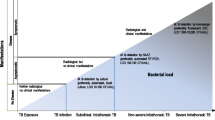Abstract
Isolation of mycobacterium tuberculosis is the gold standard in the diagnosis of childhood tuberculosis. However, it has inherent limitations due to paucibacillary nature of the disease in children and technical difficulties encountered in collection of appropriate sample. Thus, diagnosis is dependent on circumstantial evidence at best supported by conventional tests such as tuberculin test and chest radiograph. Several new tests are being developed but they lack ideal sensitivity and specificity. Hence, it is important to optimise use of current diagnostic tests. Clinical suspicion based on protocol developed by IAP is a pre-requisite of ordering tests and it is only then that proper interpretation is possible. Tuberculin skin test is still a useful screening test. It does help in establishing presence of infection though not necessarily disease. Attention must be paid to ideal test solution, proper technique and cautious interpretation. BCG test is not recommended. Miliary shadows and fibrocaseious cavitary lesions in chest radiograph are highly suggestive of tuberculosis in our epidemiology. CT scan is rarely necessary and is not cost and radiation-effective. It is ideal to attempt bacteriological examination in every suspected case of childhood tuberculosis. Most practical method is collection of gastric aspirate for smear and culture. It is possible to carry out this procedure in out-patient clinic. Better yield is likely with increasing expertise especially in extensive disease. Bronchoalveolar lavage is an invasive test and bacterial yield is comparable to that of gastric aspirate. Tissue collected for histopathological examination must be submitted for bacteriolgocal tests. PCR is not easily available. It has high sensitivity but lower specificity and thus, is not routinely recommended. Serology has no place in diagnosis of tuberculosis. Interferron gamma release assays are also now available. Sensitivity and specificity of Quantiferon Gold and T-spot tests have not been studied in children and hence are not recommended in routine practice. Instead of trying newer tests, it may be best to avail an expert advice in difficult cases.
Similar content being viewed by others
References
IAP working group. Consensus statement on childhood tuberculosis. Indian Pediatr. 2010;47:41–55.
James SH. Healthcare worker knowledge of measurement and documentation of tuberculin skin test reaction. Infect Control Hosp Epidemiol. 2009;30:1230–2.
Sleiman R. Interpretation of the tuberculin skin test in bacille Calmette-Guerin vaccinated and nonvaccinated school children. Pediatr Infect Dis J. 2007;26:134–8.
Araujo Z, de Waard JH, de Larrea CF, Borges R, Convit J. The effect of bacilli-calmette-guerin vaccine on tuberculin reactivity in indigenous children from communities with high prevalence of tuberculosis. Vaccine. 2008;26:5575–81.
Wang L, Turner MO, Elwood RK, Schulzer M, FitzGerald JM. A meta-analysis of the effect of bacilli-calmette-guerin vaccination on tuberculin skin test measurements. Thorax. 2002;57:804–9.
Singla M, Sahai V, Sodhi S, Gupta RP. BCG skin reaction in mantoux negative healthy children. BMC Infect Dis. 2005;5:19–20.
Swaminathan S, Raghavan A, Datta M, Paranasivan CN, Saravanan KC. Computerised tomography detects pulmonary lesions in children with normal radiographs diagnosed to have tuberculosis. Indian Pediatr. 2005;42:258–61.
Pomputius WF, Rost J, Dennehy PH, Carter EJ. Standardization of gastric aspirate technique improves yield in the diagnosis of tuberculosis in children. Pediatr Infect Dis J. 1997;16:222–6.
Lobato MN, Loeffler AM, Furst K, Cole B, Hopewell PC. Detection of Mycobacterium tuberculosis in gastric aspirates collected from children—hospitalisatioon is not necessary. Pediatrics. 1998;102:E 40.
Andersen D. Microbiological diagnostic procedures in respiratory infections and mycobacterial infection. Pediatr Respir Rev. 2007;8:221–30.
Laven GT. Diagnosis of tuberculosis in children using fluorescence microscopic examination of gastric washings. Am Rev Resp Dis. 1977;115:743–9.
Abadco DL, Steiner P. Gastric lavage is better than bronchoalveolar lavage for isolation of mycobacterium tuberculosis in childhood pulmonary disease. Pediatr Infect Dis J. 1992;11:735–8.
Somu N, Swaminathan S, Paramasivan CN, et al. Value of bronchoalveolar lavage and gastric lavage in the diagnosis of pulmonary tuberculosis in children. Tuber Lung Dis. 1995;76:295–9.
Singh M, Moosa NVA, Kumar L. Role of gastric lavage and broncho-alveolar lavage in the bacteriological diagnosis of childhood pulmonary tuberculosis. Indian Pediatr. 2000;37:947–51.
Franchi LM, Cama RI, Gilman RH, Montenegro-James S, Sheen P. Detection of Mycobacterium tuberculosis in nasopharyngeal aspirate samples in children. Lancet. 1998;352:1681–2.
Zar HJ, Hanslo D, Apolles P, Swingler G, Hussey G. Induced sputum versus gastric lavage for microbiological confirmation of pulmonary tuberculosis in infants and young children: a prospective study. Lancet. 2005;365:130–4.
Zar HJ, Tannenbaum E, Apolles P, Roux P, Hanslo D, Hussey G. Sputum induction for the diagnosis of pulmonary tuberculosis in infants and young children in an urban setting in South Africa. Arch Dis Child. 2000;82:305–8.
Yeager Jr HJ, Lacy J, Smith L, LeMaistre C. Quantitative studies of mycobacterial populations in sputum and saliva. Am Rev Respir Dis. 1967;95:998–1004.
Dundar D. Routine using pattern and performance of diagnostic tests for tuberculosis on a university hospital. Am J Med Sci. 2010;339:244–8.
Dinnes J. A systematic review of rapid diagnostic tests for the detection of tuberculosis infection. Health Technol Assess. 2007;11:192–6.
Lighter J. Latent tuberculosis diagnosis in children by using the QuantiFERON-TB Gold In-Tube test. Pediatrics. 2009;123:30–7.
Diel R. Evidence based comparison of commercial interferon-gamma-release assays for detecting active TB—a meta-analysis. Chest. 2010;137:272–5.
Han YM, Kim SH, Kim CH, Kang HJ, Lee KM. Analysis of patients with positive AFB culture and negative T.Spot.TB. Korean J Lab Med. 2010;30:414–9.
Steingart KR, Henry M, Laal S. A systematic review of commercial serological antibody detection tests for the diagnosis of extrapulmonary tuberculosis. Thorax. 2007;62:911–8.
Gambhir IS, Mehta M, Singh DS, Khanna HD. Evaluation of CSF adenosine deaminase activity in tubercular meningitis. J Assoc physicians India. 1997;47:192–4.
Sohn H, Minion J, Albert H, Dheda K, Pai M. TB diagnostic tests: how do we figure out their costs? Expert Rev Anti Infect Ther. 2009;7:723–33.
Glaszior P, Irwig L, Deeks JJ. When should a new test become the current reference standard. Ann Intern Med. 2008;149:816–22.
Author information
Authors and Affiliations
Corresponding author
Rights and permissions
About this article
Cite this article
Amdekar, Y.K. How to Optimize Current (Available) Diagnostic Tests. Indian J Pediatr 78, 340–344 (2011). https://doi.org/10.1007/s12098-010-0286-8
Received:
Accepted:
Published:
Issue Date:
DOI: https://doi.org/10.1007/s12098-010-0286-8




